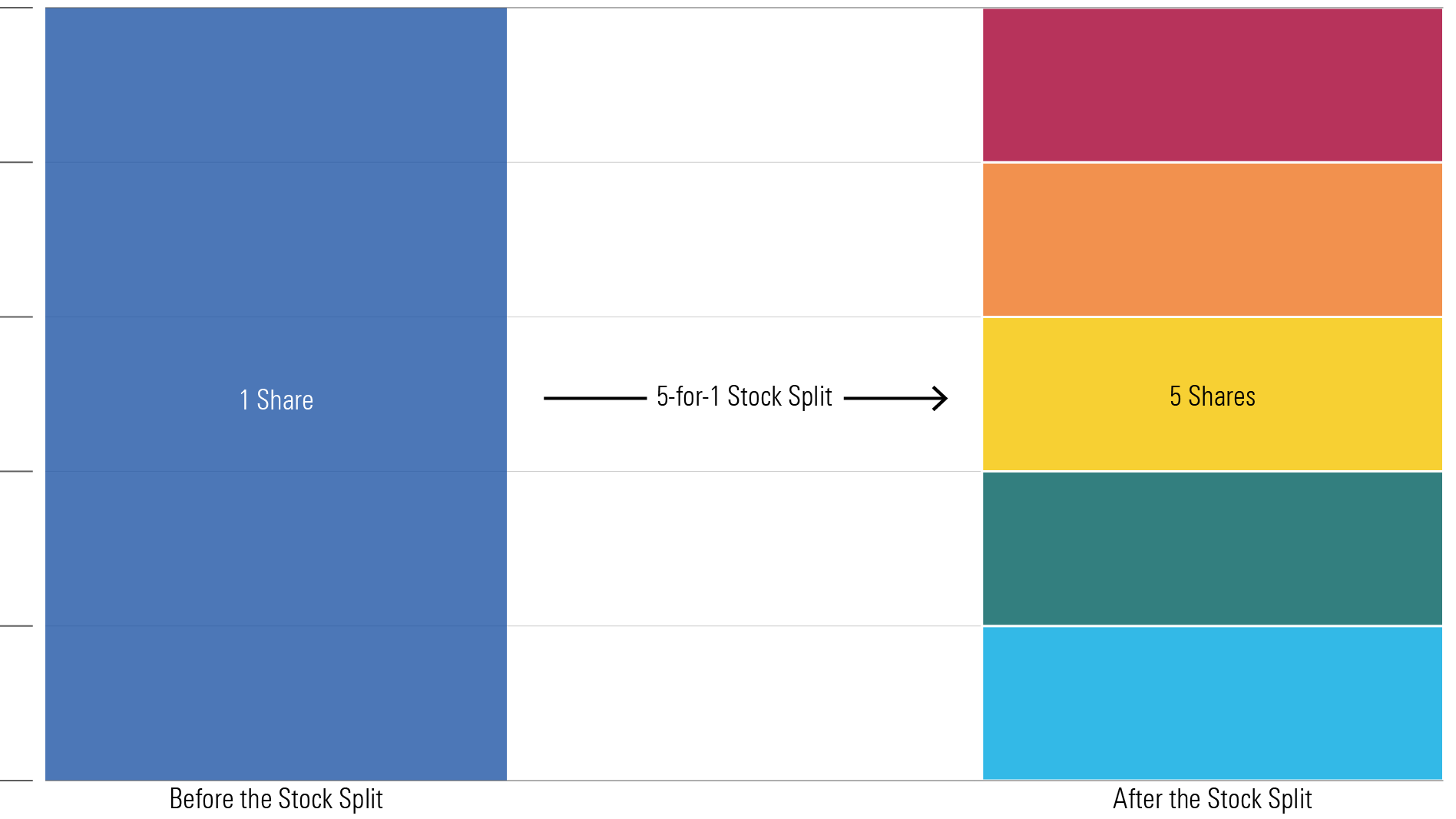What Is a Stock Split?
Companies like to play with the price of their stocks. Here’s why and what you should know.

Big-name companies with lofty stock prices often make waves when they announce stock splits, but these moves may leave investors with questions. What is a stock split? What does it mean? How does it affect me as an investor? How does it affect the company?
We cover what investors should know about stock splits and why companies choose to do them.
What Happens When a Stock Splits?
Simply put, a stock split is exactly what it sounds like. One share gets divided, or split, into multiple shares. Don’t worry, though. The value of your holdings is the same, just in smaller chunks.
Think about a stock split like a chocolate bar. Your one big chocolate bar is broken down into multiple bite-size pieces. You still have the same amount of chocolate, just in smaller segments.
Similarly, in a stock split, it is very important to remember that the price of the share also is reduced. For example, if a company board announces a 2-for-1 split, then you get one extra share for each share you own--but the share price will be halved. In this example of a 2-for-1 split, if you had one share of Company X at $10 per share, you now have two shares of Company X at $5 per share.
This does not mean that the stock has become cheaper. The fundamentals of the company and the stock price have not changed. Sticking with the chocolate bar analogy, after breaking the bar into smaller bits, you have smaller bits of chocolate, not more chocolate overall.
What Is a Stock Split?

Why Does a Company Split Stock?
Why do companies announce stock splits? Stock splits are a way for companies to increase their overall liquidity.
Liquidity means the ease with which investors can buy or sell shares on a stock exchange. The less each share costs, the less money is needed by even the smallest investor to buy or sell the stock. Plus, having a larger number of cheaper shares can have the psychological impact of making shares more attractive to investors, even though the company’s underlying value hasn’t changed.
In most cases, stock splits are undertaken by companies when the share price has gone up significantly, particularly in relation to a company’s stock market peers. If the share price becomes more affordable for smaller investors, it can reasonably be assumed that more investors will participate, and so the overall liquidity of the stock would increase as well.
But remember this with stock splits: Though the number of outstanding shares changes, and though the price of each share changes, the company’s overall market cap stays the same. The value of the company doesn’t increase when a split occurs, therefore the value of your stocks, your shares, doesn’t change, either.
Take Chipotle CMG for example. When the company announced its upcoming 50-1 split on June 6, 2024, one share sold for about $3,100-$3,200. Many investors (myself included) would not be able to invest in Chipotle, because I do not have $3,000-odd to invest in one share of one company. The split took effect on June 26, 2024, and shares dropped to around $65 a piece, with each existing shareholder receiving 49 additional shares for every share they own. A stock price of $65-odd is much more manageable, both for me and for many others.
This is especially true now with more and more investors having access to low-cost trading platforms. Buying and selling stocks is now easier than ever, and for many investors these recent splits might be an entry point into companies they have long admired.
All this being said, these recent high-profile splits seem superfluous given that most brokerage platforms now enable trading in fractional shares. Perhaps the psychology of owning at least one whole share is at play in the companies’ decisions.
“When we look at a company like Chipotle and strictly observe the value of an investment immediately after a stock split, there really isn’t a discernable pattern in the change in wealth. What is noticeable is the trading volume of the stock which might be attributed to news flow. All this said, for long-term investors in a stock, a stock split (or reverse split) really doesn’t affect the fundamental value of the company or the wealth in your pocket,” points out Morningstar Canada’s director of Investment Research Ian Tam.
Does the Company Change After a Stock Split?
Not at all. Stock splits do not alter the fundamentals of the company in any way, apart from the short-term price increases we described earlier. There’s no harm done in this regard if the stock doesn’t split either.
Recent high-profile stock splits include Chipotle, Broadcom AVGO, Nvidia NVDA, and Walmart WMT. Alphabet GOOGL/GOOG, Tesla TSLA, and Amazon AMZN split shares in 2022.
What Is a Reverse Stock Split?
The opposite of a stock split, which is technically called a forward stock split, is a reverse stock split.
In the case of reverse stock splits, the company divides the number of shares that investors own, rather than multiplying them. As a result, the price of the shares increases.
For instance, if you own 10 shares of Company X at $10 per share, and the company announces a 1-for-2 reverse stock split, you end up owning five shares of Company X at $20 per share. Usually, reverse stock splits are announced by companies that have low share prices and want to increase them--often to avoid being delisted.
Is a Reverse Stock Split a Bad Sign?
You may think that reverse stock splits are bad news for the company, but this is not always the case. One of the most famous examples of reverse stock splits is Citigroup C. Its share price declined to under $10 during the 2008 global financial crisis and stayed there, so in 2011 the Citigroup board decided to do a reverse split of 1-for-10. The split took the price from $4.50 per share to $45 per share. The company--and the stock--survived and is now trading at around $61 per share.
See, just math!
The author or authors do not own shares in any securities mentioned in this article. Find out about Morningstar’s editorial policies.

/s3.amazonaws.com/arc-authors/morningstar/52a57b68-8d99-4364-96af-9ffc6a124531.jpg)
/s3.amazonaws.com/arc-authors/morningstar/96c6c90b-a081-4567-8cc7-ba1a8af090d1.jpg)
/d10o6nnig0wrdw.cloudfront.net/06-28-2024/t_1377507e2da0485faab7721e212e9baf_name_file_960x540_1600_v4_.jpg)
/cloudfront-us-east-1.images.arcpublishing.com/morningstar/RXEHKWMHQNDBLD3ZFOOZOB5VIU.png)
/cloudfront-us-east-1.images.arcpublishing.com/morningstar/HU3X6PAILNCOVAUSKMJBJCVK6U.jpg)
:quality(80)/s3.amazonaws.com/arc-authors/morningstar/52a57b68-8d99-4364-96af-9ffc6a124531.jpg)
:quality(80)/s3.amazonaws.com/arc-authors/morningstar/96c6c90b-a081-4567-8cc7-ba1a8af090d1.jpg)